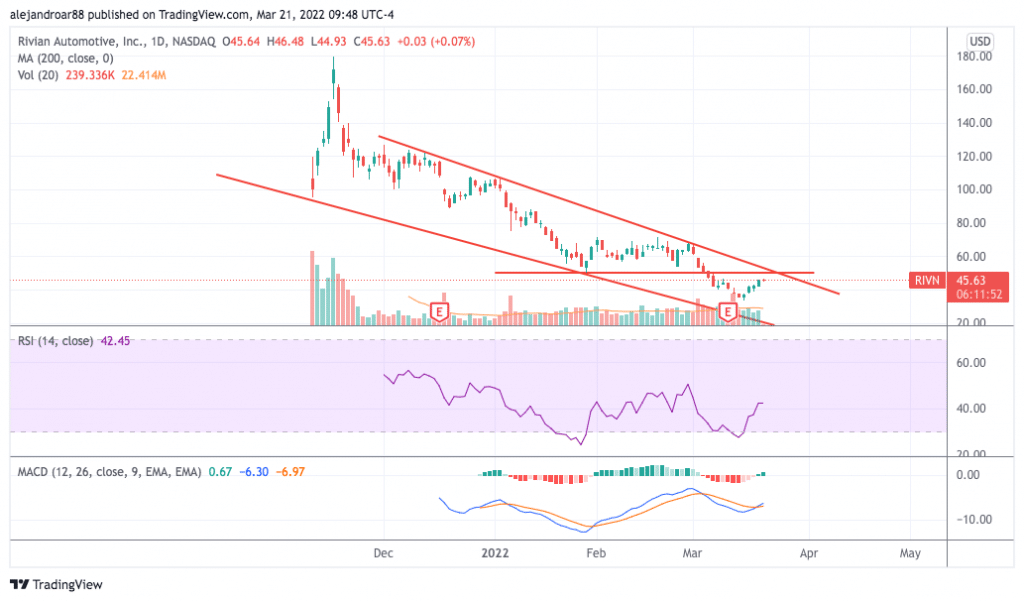Rivian Stock Down 33% in March – Time to Buy RIVN Stock?
Please note that we are not authorised to provide any investment advice. The content on this page is for information purposes only.
The price of Rivian stock has gone down nearly 33% so far this month as the riskier segments of the equity markets have been severely battered by changes in the macroeconomic landscape and geopolitical tensions.
The Federal Reserve recently confirmed that it will be hiking its benchmark interest rate at least 7 times this year – once per every meeting – with the first one occurring in the form of a 25 basis points increase only a few days ago.
Meanwhile, tensions between the United States, the European Union, and other countries with Russia amid the invasion of Ukraine have prompted a risk-off move in the markets as participants rushed to protect themselves from the ripple effects of a potential escalation in the armed conflict.
In this context, the value of Rivian (RIVN) stock has dropped quite sharply as the company’s weak fundamentals make it a risky bet for most investors nowadays.
On 10 March this year, the company released its financial results covering the fourth quarter of the year. Revenues for the period ended at $54 million with the company delivering a total of 909 vehicles. The consensus revenue estimate for the period stood at $60.7 million according to data from Capital IQ.
Meanwhile, deliveries during the entire 2021 fiscal year ended at 920 units while total revenues stood at $55 million.
During the entire year, Rivian produced operating losses of $4.22 billion and net losses of $4.69 billion. Meanwhile, the firm’s adjusted EBITDA stood at minus $2.79 billion compared to minus $992 million the firm reported in 2020.
The company’s negative free cash flows ended the year at $1.76 billion while its cash reserves stood at $18.42 billion including cash, equivalents, and restricted cash.
For 2022, the company expects to deliver 25,000 vehicles and report a negative adjusted EBITDA of $4.75 billion. Capital expenditures for this year are expected to land at $2.6 billion as the company continues to ramp up its manufacturing capacity.
Meanwhile, on 14 March, Rivian informed investors that it appointed Frank Klein as its new Chief Operating Officer. Klein is a former Daimler AG executive with over 25 years of experience in the automotive industry.
Mr. Klein will be in charge of overseeing the rapid scaling of the company’s Normal, Illinois manufacturing plant along with other projects.
Shares of Rivian have been increasing in the past few days following the release of this quarterly report and news about the appointment of a new COO.
What could be expected from this electric vehicle stock following these latest developments? In this article, I’ll be assessing the price action and fundamentals of RIVN stock to outline plausible scenarios for the future.
67% of all retail investor accounts lose money when trading CFDs with this provider.
Rivian Stock – Technical Analysis

The price of Rivian stock has declined 56% so far since 2022 started and remains on a sharp downtrend since the post-IPO run-up collapsed.
Multiple relevant areas of support have been broken along the way including the $95, $75, and $50 level and that favors a bearish outlook for Rivian in the near term.
Right now, the stock is approaching the $50 level and, depending on how the price action behaves after tagging this key threshold, there will be more evidence to support a bullish or bearish outlook.
Momentum indicators are still bearish despite the recent 4-day rally as the Relative Strength Index (RSI) is standing at 42 while the MACD is still neck-deep into negative territory even though histogram readings have turned positive at the same time the oscillator has crossed above the signal.
All things considered, the outlook for Rivian stock remains bearish unless the price decisively moves above the $50 level in the next few days.
Rivian Stock – Fundamental Analysis
Analysts remain concerned that Rivian could be struggling with its supply chain as indicated by the company’s relatively weak guidance for its deliveries in 2022.
In this regard, Wedbush, one of the financial services firms that cover RIVN, categorized this forecast as “soft” and emphasized that it could be hinting at unforeseen supply chain issues and other similar challenges.
According to analysts from the firm, the company has the potential to become a major player in the EV landscape but it needs to address these issues and fix them quickly to start delivering vehicles as soon as possible.
The firm also said that more public relations issues “could end the growth story before it began”. Wedbush lowered its price target for the firm to $60, down from a previous 12-month forecast of $130 per share.
Many other financial services firms lowered the price targets for Rivian stock as well following the release of this quarterly earnings report.
Rivian’s sizable cash reserves are probably sufficient for the company to stay afloat in the next one to two years. However, if the management is unable to live up to the market’s ambitious targets, the valuation could continue to suffer and that would endanger the firm’s ability to keep finding cheap financing.
Overall, Rivian remains a risky bet in the EV market and its $41 billion valuation seems to still be pricing a blue-sky scenario where the firm faces little to no challenges to deliver the kinds of volumes needed to justify that price tag.






